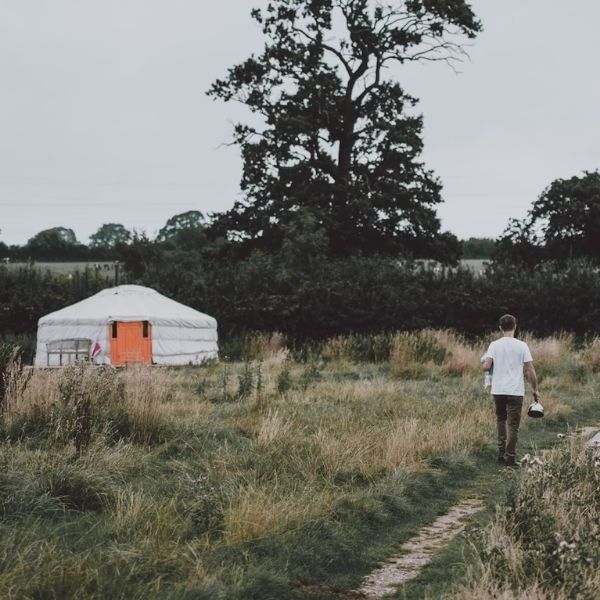Canvas tents can last for a lifetime if properly cared for. But just like maintaining a healthy diet, tent maintenance requires dedication, proactive measures, and obsessive anxiety over mortality.
Hopefully you proactively sought this article before stains or fungi have found their way to your canvas. If not, we have some advice below these tent tips that can help you clean and care for your best canvas tent to help give you a generation of use out of your bell tent.
10 Tips to Maintaining a Bell Tent
Prevention is the key to elongating the life of your bell tent. Below are important steps to take before, during, and after using your bell tent to ensure that it stays in tippy-top condition.

-
Do Not Pitch Your Tent Directly Under a Tree Or Against Foliage
Yes, shade is amazing during the summer time, but trees tend to attract birds, and branches are their outhouse, and your tent is below their outhouse. Trees also can secrete sap, and for some reason canvas is an amazing attractant for this stuff.
Full shade also blocks the sun, which helps to dry any moisture off of your tent walls, ceiling and from around your floor – thus preventing mold.
You can get away with pitching your tent wall snug against tall grass and plants for a couple of days, but avoid doing so for weeks at a time. This foliage will trap moisture against your tent and is the perfect incubator for fungus growth.
-
Vent Your Bell Tent
Canvas is one of the most breathable fabrics for camping, but certain humidity can still create condensation on the inside of your tent. Open screened windows and doors periodically to allow a breeze to relieve any condensation.
If your canvas tent is in a high humid environment, then venting your tent might not be enough. Also consider running a fan of a dehumidifier. For and even stronger defense, you could benefit from regularly running a wood burning stove or propane heater inside the tent every week to help drive out any moisture, regardless of the heat index outside.
-
Use a Ground Tarp
Condensation will get trapped between the floor of your tent and the ground no matter where you pitch your tent. Using a ground cloth under your tent will not only minimize condensation, it will also protect your floor from sticks and stones – not to mention reduce the amount of wiping when you pack up. Check out our bell tent ground tarps on our online shop if you are in the market for one.
-
Do Not Pack Your Tent Up Wet or Covered With Leaves or Grass
A wet, packed up tent creates the best conditions for mold to grow. If you must pack it up damp, dry your tent out within a few days so that you don’t need to read further down in this article.
Organic material left on your tent, such as leaves or grass, can also lead to mold growth. So do your best to clear debris off before rolling up your tent.
-
Sweep & Wipe Your Tent Floor Before Packing It Up.
Any dirt, hair, and mud on the floor of your tent will end up on your ceiling when you fold up your tent. We suggest laying down some rugs in your tent and bring along a broom or cordless vacuum to help avoid the annoying task of cleaning your ceiling during your next adventure.
-
Keep Mud Off of Your Guy Lines
Muddy guy lines get folded up with your tent. Guess what happens to that mud? Yep, it creates lovely mud splatter designs on your canvas. The best way to avoid this is to carefully pull dirty tent pegs out of the ground and avoid contact with the guy line ropes during removal. Better yet, attached your guy line ropes to your tent with carabiners. Not only are these easy to remove, they also protect your tent from rope burn.
-
Wipe Moisture From The Bottom of Your Tent Floor
The bottom of your tent will likely have some condensation or water on it. Bring along a towel to dry off this water as you fold up your tent to avoid the possibility of mold growth while your tent is in storage.
-
Store Your Bell Tent In a Cool and Dry Location.
Right next to your wine, street bike, or photo albums should do just fine. Just make sure that the sun or rodents won’t bathe on it. As added security, store your tent in a rubber or plastic container, off the ground - but again, make sure that the location chosen won't be hot or humid.
-
Clean Your Bell Tent
Use a mild soap, hot water, a soft brush, some elbow grease and patience. Using your garden hose with a powerful spray nozzle most likely will be necessary as well. Our favorite tool to spray off a canvas tent is this high pressure garden hose wand.
See below for more details on cleaning your canvas tent. -
Retreat Your Canvas Regularly
Your canvas likely comes with an extra waterproofing treatment that helps repel water and mildew. This treatment will wear off the more your tent is used. You'll know it is time to retreat your canvas when water no longer beads up and rolls down the canvas. Likely this will occur after about 60 days of use. 303 Fabric Guard and Dry Guy waterproofing sprays are two great products to accomplish this. The below regional map suggest how frequently you should perform this process based on the likely humidity levels in your micro-climate:













